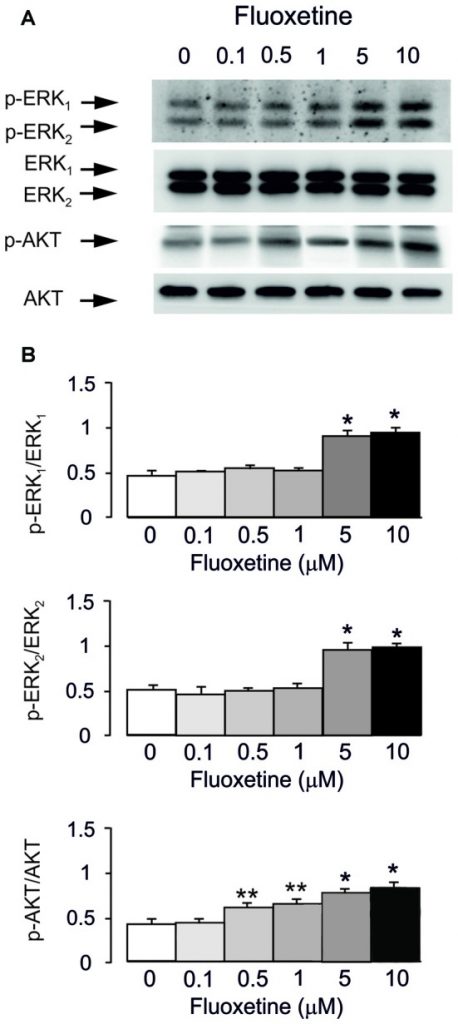Previously, we reported that fluoxetine acts on 5-HT2B receptor and induces epidermal progress concern receptor (EGFR) transactivation in astrocytes. Recently, we now have now found that continuous remedy with fluoxetine regulates Caveolin-1 (Cav-1)/PTEN/PI3K/AKT/glycogen synthase kinase 3β (GSK-3β) signaling pathway and glycogen content material materials in main cultures of astrocytes with bi-phasic focus dependence.
At low concentrations fluoxetine down-regulates Cav-1 gene expression, decreases membrane content material materials of PTEN, will improve PI3K train and will improve phosphorylation of GSK-3β and will improve its train; at extreme concentrations fluoxetine acts on PTEN/PI3K/AKT/GSK-3β in an inverse type.
Here, we present the data indicating that acute remedy with fluoxetine at lower concentrations down-regulates c-Fos gene expression via PI3K/AKT signaling pathway; in distinction at bigger concentrations fluoxetine up-regulates c-Fos gene expression via MAPK/extracellular-regulated kinase (ERK) signaling pathway.
However, acute remedy with fluoxetine has no impression on Cav-1 protein content material materials. Similarly, continuous outcomes of fluoxetine on Cav-1 gene expression are suppressed by inhibitor of PI3K at lower concentrations, nevertheless by inhibitor of MAPK at bigger concentrations, indicating that the mechanism underlying bi-phasic regulation of Cav-1 gene expression by fluoxetine is opposing outcomes of PI3K/AKT and MAPK/ERK signal pathways on c-Fos gene expression.
The outcomes of fluoxetine on Cav-1 gene expression at every lower and bigger concentrations are abolished by AG1478, an inhibitor of EGFR, indicating the involvement of 5-HT2B receptor induced EGFR transactivation as we reported beforehand. However, PP1, an inhibitor of Src solely abolished the impression by lower concentrations, suggesting the relevance of Src with PI3K/AKT signal pathway all through activation of EGFR.

Identification of Caveolin-1 as an Invasion-Associated Gene in Liver Cancer Cells Using Dendron-Coated DNA Microarrays.
The commonplace gene expression profiling approaches have been modified with DNA microarrays with exhibiting a robust high-throughput functionality. Most steady surfaces of DNA microarrays embody such a extreme area density of purposeful groups to immobilize seize DNAs to the ground that the hybridization of seize DNAs with cDNA may very well be hindered, ensuing in low depth and reproducibility.
Since our earlier works confirmed that the 9-acid dendron was capable of enhance the hybridization effectivity, we aimed to show the feasibility of 9-acid dendron-coated glass slides as a complicated microarray platform for gene expression profiling.
The 9-acid dendron-coated DNA microarray could reproducibly get maintain of the expression ranges of 2800 human cancer-associated genes in the two liver most cancers traces: Hep3B and SK-Hep1.
Among the differentially expressed genes, Caveolin-1 (Cav-1) was acknowledged as primarily essentially the most extraordinarily up-regulated gene in invasive SK-Hep1 in comparability to non-motile Hep3B. The overexpression of Cav-1 in Hep3B promoted the cell invasion, whereas its knockdown in SK-Hep1 suppressed the invasive perform, which confirms that the overexpression of Cav-1 is fastidiously associated to cell invasion of liver carcinoma. Collectively, the 9-acid dendron-coated ground could effectively detect the transcript ranges of cells, demonstrating its potential potential to find out the candidate genes for added purposeful analysis or prognosis of diseases.
